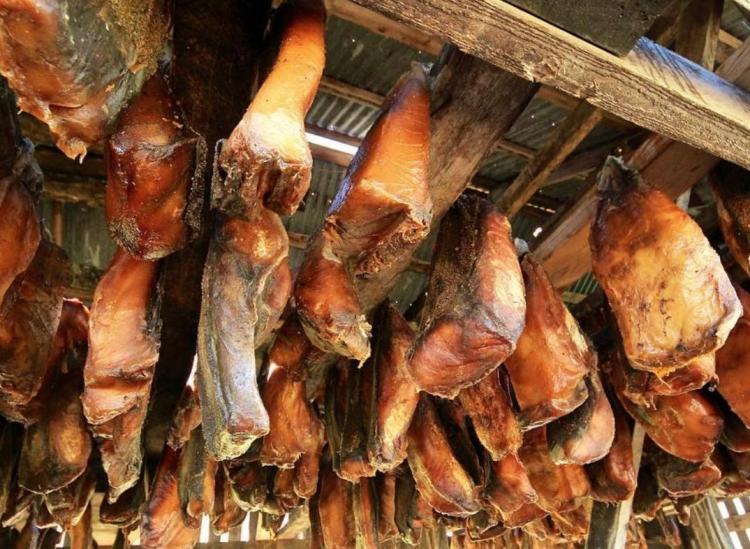Only The Most Adventurous Eaters Can Handle These Crazy Foods

@andyheadlong
Even if you consider yourself an adventurous eater, there’s always room for improvement. Different cultures around the world form their cuisine around what’s accessible. Something that seems common and normalized in one part of the world might seem insane in another. When some people visit America, they see a chili dog on the menu and get confused as hell. It’s all relative to what you’re used to. Here are 12 strange AF dishes around the globe.
1. Crispy Tarantulas — Cambodia
Anyone with arachnophobia steer clear. Once June comes around, it’s tarantula season in Cambodia. This means the local delicacy is back on the menu as rainy season comes into full swing. The spiders are prepared with sugar and salt and then cooked in hot oil, making for a crunchy, salty snack. Eeeek.
2. Airag — Mongolia
Airag is the traditional national beverage of Mongolia. Milk from a female horse is filtered through a cloth, poured into a large open leather sack and stirred with a wooden masher. When mare’s milk is fermented, the lactose is destroyed, which makes it easy to digest for lactose intolerant people.
3. Muktuk — Greenland
Made from the skin and blubbler of the bowhead whale, muktuk is either eaten raw or finely diced, breaded, deep fried and served along with soy sauce. Muktuk is also sometimes pickled. When you chew the whale blubber it becomes oily and has a sort of nutty taste.
4. Century Egg — China
A century egg, also known as a preserved egg, millennium egg or black egg is a Chinese delicacy that’s made by preserving a duck, chicken or quail egg. The eggs are encased in a mixture of clay, ash, salt, quicklime and rice hulls. The yolk becomes grey in color with a creamy consistency and develops a strong flavor because of the ammonia. The white part of the egg becomes a dark brown, translucent jelly with a salty flavor. Sometimes the egg is eaten with pickled ginger root or is chopped up with chilled tofu.
5. Locusts — Israel
Locusts, a certain kind of short-horned grasshopper, are apparently the only insect considered kosher. Specific parts of the Torah actually mention that four different types of locusts can be eaten. In certain parts of Israel, locusts are dropped into boiling water, cleaned, rolled in a mixture of flour, coriander seeds, garlic and chili powder and then deep fried. Just your average crunchy snack.
6. Escamoles — Mexico
Escamoles, or aunt larvae, is a dish native to Central Mexico. Light-colored eggs are harvested from maguey plants. They slightly resemble white corn kernels or pine nuts. They have a crunchy texture when they’re fried and a slightly nutty taste. Escamoles are often pan-fried and sauteed with butter and spices and added to tacos and omelets in Mexican cuisine.
7. Balut — The Philippines
Ugh. A balut is a developing bird embryo, usually a duck, that’s boiled and eaten from the shell. It’s commonly sold as a street food in the Philippines and it’s served with beer. The eating of balut is pretty controversial because of religious beliefs, health risks and animal welfare conditions, but people still do it.
8. Hákarl — Iceland
Known as a national dish of Iceland, hákarl is a dish of shark meat that’s cured and rotten. The smell is extremely putrid. Anthony Bourdain describes hákarl as “the single worst, most disgusting and terrible tasting thing.” In Iceland, it’s served in cubes or on toothpicks. First-timers may gag involuntarily on their first attempts to eat it.
9. Moose Nose — Canada
In certain parts of Canada, moose nose is considered a delicacy. Once all of the nose hairs are burnt off during singeing, it’s ready to cook. Moose nose can be sliced, soaked in salty water and slow cooked as a part of a stew or eaten on its own with salt and pepper.
10. Bird’s Nest Soup — China
Prized in Chinese culture, bird’s nest soup is one of the most luxurious and expensive delicacies. Each bird’s nests retail for about $105 each. It’s also seen as a holistic medicinal concoction thought to potentially strengthen the immune system and increase libido. The nests are made out of bird saliva, which is dried and hardened. The soup has a gelatinous texture that you definitely won’t forget. Here’s how they make bird’s nest soup.
11. Live Octopus — Japan and Korea
In Korea, it’s called sannakji. Eating live octopus that’s been cut into small pieces or prepared whole can be an alarming situation. It’s basically served with its arms still squirming. People who like it, want the taste of the fresh octopus. It’s advised to chew it before swallowing to avoid being choked.
12. Durian Fruit — Malaysia
The large tropical fruit distinguished by its spiky hard outer shell has a smelly, custard-like flesh with large seeds. It’s used in both sweet and savory dishes and its taste can be described as a combination of cheese, almonds, garlic and caramel, all at the same time. People make juices with it, put it in soups or use it as a side dish.











